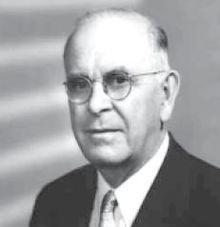Harold W. Clark
After years of church-school teaching, he enrolled at Pacific Union College in 1920, where he studied under (the newly arrived) Price.
He graduated two years later and replaced Price (who had accepted a position at Union College, Nebraska) on the faculty.
[4] That summer, and a number of vacations thereafter, he spent studying glaciation, coming (in the 1930s) to the conclusion that large proportions of North America had been covered in ice for as long as one and a half millennia after the flood — a view that was anathema to Price.
In 1938, Clark visited the oil fields of Oklahoma and Northern Texas, where his observation of deep drilling confirmed long-standing suspicions that there existed a meaningful geological column, a position adamantly denied by Price.
Clark attributed this column to antediluvian ecologies ranging from ocean depths to mountaintops, rather than the successive layers through deep time of mainstream geology.
